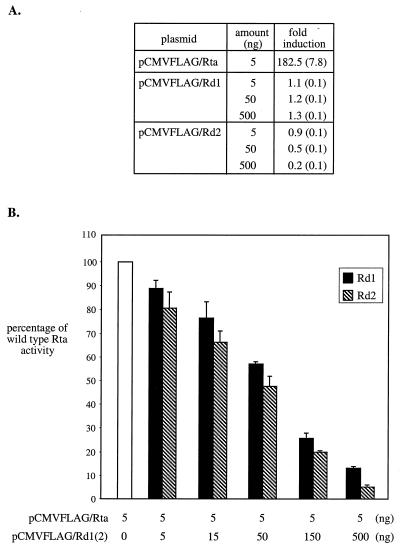FIG. 2.
Rd1 and Rd2 function as dominant-negative mutants of Rta in 293T cells. (A) Rd1 and Rd2 do not activate the ORF57 promoter. 293T cells were cotransfected with 50 ng of the reporter construct, p57Luc, and 5 ng of pCMVFLAG/Rta, or 5 to 500 ng of pCMVFLAG/Rd1, or 5 to 500 ng of pCMVFLAG/Rd2. The total amounts of plasmid DNA were brought up to 600 ng with pCMVFLAG. The control transfection was carried out with 550 ng of pCMVFLAG and 50 ng of p57Luc. Each transfection included 1 ng of pRLCMV containing the Renilla luciferase gene driven by the constitutively active CMV promoter for nomalization of variations among transfections. At 48 h posttransfection, total cell lysates were harvested for analysis of luciferase activity. Normalized luciferase activity was calculated by dividing the level of firefly luciferase activity by the level of Renilla luciferase activity in each transfection. The fold induction was then calculated by dividing the level of normalized luciferase activity by that of the control transfection. Standard deviations derived from four experiments are shown in parentheses. (B) Rd1 and Rd2 inhibit wild-type Rta trans-activation of the ORF57 promoter. 293T cells were transfected with 50 ng of p57Luc and 5 ng of pCMVFLAG/Rta alone or with 5 to 500 ng of pCMVFLAG/Rd1 or 5 to 500 ng of pCMVFLAG/ Rd2. Total cell lysates were harvested at 48 h posttransfection, and the luciferase activity in each transfection was measured. The fold induction was calculated as described above. Wild-type Rta activity was expressed as the percentage of the fold induction relative to cotransfection of p57Luc and pCMVFLAG/Rta. Standard deviations derived from four experiments are expressed as error bars.

